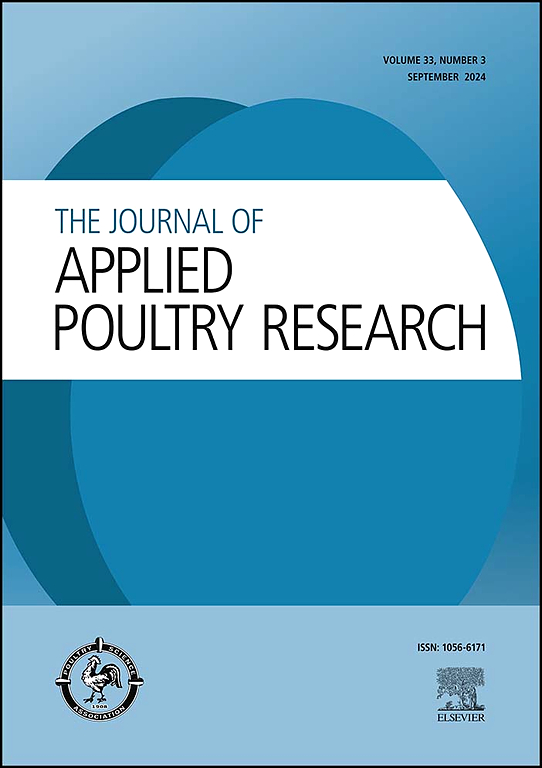Effect of various processing factors on the pH, water activity and microbiological characteristics of pickled Japanese quail (Coturnix c, japonica) eggs
IF 2
3区 农林科学
Q2 AGRICULTURE, DAIRY & ANIMAL SCIENCE
引用次数: 0
Abstract
This study determined the effect of different commercial pickling errors on pH, water activity and microbiology of hard cooked quail eggs. Experiment 1 tested pH and water activity of cooled and hot hard cooked eggs held for 24 or 48 h in tap water (control) or commercial pickling solution. Experiment 2 examined FDA's 24 h acidification requirement by evaluated egg microbiology after 24 h of storage in commercial brine (5 % vinegar containing 1.5 % sugar (w/v) and 4.3 % salt (w/v)), or in brine missing salt, sugar or both salt and sugar. Hard-cooked eggs were prepared and inoculated in experiment 2 on the peeled surface with a mixed culture of Escherichia coli, Listeria monocytogenes, and Salmonella Typhimurium. A subset of raw eggs was inoculated in the yolk before boiling and surface inoculated. Egg yolk pH and egg albumen pH decreased to 3.9 after 24 h in commercial brine, which is below the pH (4.6) recommended by FDA for safety. Numbers of Salmonella Typhimurium, Listeria monocytogenes, Escherichia coli and coliforms recovered from eggs pickled in commercial brine or brine missing either salt, sugar or both were below the detection limit (< 1.4 log cfu/g egg) after 24 h of holding time. Levels of Salmonella Typhimurium, E. coli and coliforms were detectable on pickled eggs inoculated in the yolk before boiling and surface inoculated after boiling and peeling. This suggests that additional hurdles and environmental monitoring procedures may be needed during quail egg pickling, especially if eggs are suspected to be contaminated by both vertical and horizontal transmission.
不同加工因素对腌制日本鹌鹑蛋pH、水分活性及微生物特性的影响
本研究确定了不同商业酸洗误差对熟鹌鹑蛋pH值、水分活度和微生物学的影响。实验1测试了冷熟鸡蛋和热熟鸡蛋在自来水(对照)或商业酸洗溶液中放置24或48小时的pH和水活度。实验2通过评估鸡蛋在商业盐水(5%醋,含1.5%糖(w/v)和4.3%盐(w/v))中储存24小时后的微生物学,或在不含盐、糖或盐和糖的盐水中储存24小时,检验了FDA的24小时酸化要求。实验2将大肠杆菌、单核增生李斯特菌和鼠伤寒沙门菌混合培养,制备熟鸡蛋,接种于去皮表面。一部分生鸡蛋在煮前在蛋黄中接种,表面接种。在商业盐水中24小时后,蛋黄和蛋清的pH值降至3.9,低于FDA推荐的安全pH值(4.6)。在商业卤水或不加盐、不加糖或两者都加的卤水中腌制的鸡蛋中检出的鼠伤寒沙门菌、单核增生李斯特菌、大肠杆菌和大肠菌群数量均低于检出限(<;1.4 log cfu/g蛋),保温24 h。煮前在蛋黄处接种的腌制蛋和煮去皮后表面接种的腌制蛋检出鼠伤寒沙门菌、大肠杆菌和大肠菌群。这表明在鹌鹑蛋腌制过程中可能需要额外的障碍和环境监测程序,特别是如果鸡蛋被怀疑受到垂直和水平传播的污染。
本文章由计算机程序翻译,如有差异,请以英文原文为准。
求助全文
约1分钟内获得全文
求助全文
来源期刊

Journal of Applied Poultry Research
农林科学-奶制品与动物科学
CiteScore
4.10
自引率
10.50%
发文量
80
审稿时长
104 days
期刊介绍:
The Journal of Applied Poultry Research (JAPR) publishes original research reports, field reports, and reviews on breeding, hatching, health and disease, layer management, meat bird processing and products, meat bird management, microbiology, food safety, nutrition, environment, sanitation, welfare, and economics. As of January 2020, JAPR will become an Open Access journal with no subscription charges, meaning authors who publish here can make their research immediately, permanently, and freely accessible worldwide while retaining copyright to their work. Papers submitted for publication after October 1, 2019 will be published as Open Access papers.
The readers of JAPR are in education, extension, industry, and government, including research, teaching, administration, veterinary medicine, management, production, quality assurance, product development, and technical services. Nutritionists, breeder flock supervisors, production managers, microbiologists, laboratory personnel, food safety and sanitation managers, poultry processing managers, feed manufacturers, and egg producers use JAPR to keep up with current applied poultry research.
 求助内容:
求助内容: 应助结果提醒方式:
应助结果提醒方式:


